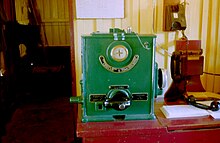railway signalling, a token is a physical object which a locomotive driver is required to have or see before entering onto a particular section of single track. The token is clearly endorsed with the names of the section it belongs to. A token system is used for single lines because of the very much greater risk of serious collision in the event of irregular working by signalmen or traincrews, than on double lines.
Electric token
The staff and ticket system was still too inflexible for busy lines, as it did not allow for the situation where the train intended to carry the actual token was cancelled or running very late. To provide for this, the electric train token system was developed. Each single-line section is provided with a pair of token instruments, one at the signal box at each end. A supply of identical tokens is stored in the instruments, which are connected by telegraph lines. A token can be removed from one instrument only if both signalmen co-operate in agreeing to the release. Once a token has been removed, another cannot be removed until the token which is "out" is replaced in either instrument. (There are variations on this sequence of events.) By this means, it can be ensured that at any one time, only one token is available to be issued to a driver. Tokens belonging to adjacent sections have different configurations to prevent them being inserted into the wrong instrument.
The operation of a bidirectional single track line has obvious problems, the most serious of which is the possibility of two trains traversing the line travelling towards each other, each driver unaware that the other is using the line. The simplest method of controlling such a line is to have only one engine operational, on the basis that a single train cannot collide with itself .
The token system was developed in Britain in the 19th century, to facilitate safe working of single-line railways. If a branch line is a dead end with a simple shuttle train service, then a single token is sufficient. The driver of any train entering the branch line (or occupying any part of it) must be in possession of the token, and no collision with another train is possible.
Staff and ticket
Using only a single token does not provide convenient operation when consecutive trains are to be worked in the same direction. The simple token system was therefore extended: if one train was to be followed by another in the same direction, the driver of the first train was required to be shown the token, but not take possession of it (in theory he was supposed to physically touch the token, but this was not strictly followed). He was given a written authority to enter the single line section, referred to as the ticket. He could then proceed, and a second train could follow. In the earliest days the second train could proceed after a designated time interval, as on double lines at the time. However, following the Armagh rail disaster of 1889, block working became mandatory.
Seeing the train staff provided assurance that there could be no head-on collision. To ensure that the ticket is not issued incorrectly, a book of numbered tickets is kept in a locked box, the key to which is permanently fastened to the token, or is the token. In addition, the lock prevents the token being removed until the ticket box is closed, and it cannot be closed unless the book of tickets is in the box. Once a ticket is issued, its number is recorded in a Train Register book, and the token is locked in a secure place. This system is known as staff and ticket.
In a variation on this principle, called divisible train staff, a section of the token referred to as the ticket portionwas designed to be removed and handed to the driver instead of a paper ticket.
Electric token
The staff and ticket system was still too inflexible for busy lines, as it did not allow for the situation where the train intended to carry the actual token was cancelled or running very late. To provide for this, the electric train token system was developed. Each single-line section is provided with a pair of token instruments, one at the signal box at each end. A supply of identical tokens is stored in the instruments, which are connected by telegraph lines. A token can be removed from one instrument only if both signalmen co-operate in agreeing to the release. Once a token has been removed, another cannot be removed until the token which is "out" is replaced in either instrument. (There are variations on this sequence of events.) By this means, it can be ensured that at any one time, only one token is available to be issued to a driver. Tokens belonging to adjacent sections have different configurations to prevent them being inserted into the wrong instrument.
Nevertheless, in the Abermule train collision in 1921, lax working procedures allowed the safeguards provided by the electric token system to be circumvented; a driver was handed a token for the wrong section, and proceeded on the mistaken belief that the token was correct. To prevent this, it became a requirement in the UK for the signals controlling entry to the single line section (starting or section signals) to be locked at danger unless a token has been released from the relevant token instrument.



